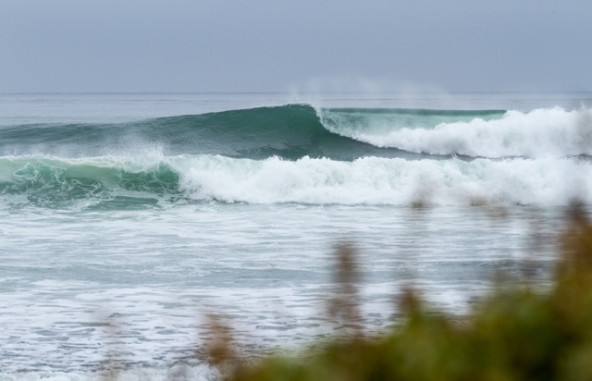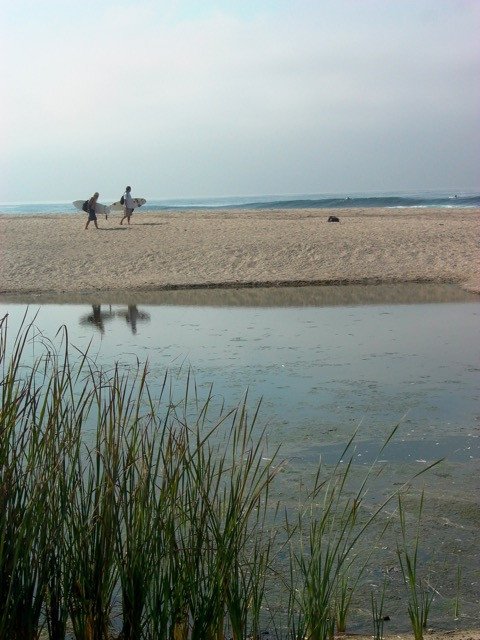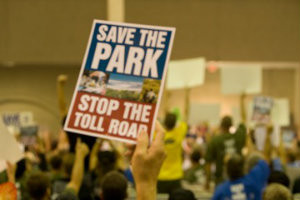"I firmly believe one of the greatest legacies we can leave to future generations is the heritage of our land. This expanse of acreage, San Onofre Bluffs State Beach, now has its future guaranteed as an official state park." —Governor Ronald Reagan, in establishing the State Park at San Onofre, April 3, 1971
What image does your mind conjure up when you imagine the perfect wave? Chances are it looks a lot like the waves at Trestles, a collection of idyllic surfing spots in San Diego County, California. For thousands of years, the Pacific Ocean has been picking itself up and arriving in perfectly sculpted cascades at this spot on the California coast, uninterrupted. In 1971, with then-Governor Reagan’s State Park dedication, it seemed assured that the waves would endure—until about a decade ago. In early 2006, California’s Transportation Corridor Agency (TCA) unveiled a plan to build a six-lane, $800-million-dollar private toll road that would run through and ultimately devastate one of the most visited and beloved state parks in California. Gone would be thousands acres of open space and the endangered species that call them home. The largely natural creek would become polluted. And those waves—shaped by sand and cobbles—would be gone.


At the Surfrider Foundation, we’re dedicated to preserving the coast and the ecosystems that define it. We couldn’t stand by and let the road happen. But we also couldn’t go into turbulent waters alone against the TCA, a well-funded agency supported by several business groups. Fortunately for us, several other groups also opposed the road, for a variety of reasons: the loss of park camping and recreational areas, the loss of or damage to a site sacred to Native Americans, and the impact on the wetlands and natural life, to name a few. So we evolved and surfed a different kind of wave: a coalition. Despite being massively out-spent, out-staffed, and out-lobbied, Surfrider fought a textbook grassroots battle to beat the TCA and save Trestles.
Building a Coalition
Our mission was simple and straightforward: Stop this bad development project from getting off the ground. Our strategy: Make it politically impossible for the project to proceed.
Many groups opposed the road, but success required that we have one, collective voice to amplify public attention to this issue and its impact on this beautiful natural resource. It also required that we build an integrated communications strategy for different audiences who cared about San Onofre for different reasons, so that ultimately we could bring together all of the individual efforts.
The Save San Onofre Coalition had two major points of strength: 1) a wide variety of resources, and 2) millions of citizens, members, and activists who coalesced into a formidable, coordinated campaign.
Save San Onofre benefitted greatly from its diverse member groups’ expertise and networks. Surfrider, for example, engaged the powerful Southern California surf industry, including billion-dollar businesses, in our Save Trestles campaign, and led grassroots organizing through a multi-channel communications engagement strategy that included group meetings, emails, public relations, and paid and earned media.
Together with our partners, we educated and inspired people to make their voices heard, and the public (including people across the globe) responded by the thousands. Surfrider held trainings with volunteers to educate communities and increase involvement; our all-volunteer chapters organized phone and letter-writing campaigns, street-corner demonstrations, and skywriting, and set up at hundreds of local events to engage community members.
In traffic-congested Southern California, radio allowed us to capture the attention of people stuck in their cars. We also relied on our website, blogs, and email to spread the word, and on TV coverage to build community support. For example, we supported a demonstration at the California State Capitol, where activists pitched 161 mini-tents to reflect the number of campsites that would be lost by the toll road, and during that protest held a press conference that garnered significant media attention. Local news coverage of such events helped fuel even greater awareness, as did several televised debates with toll road developers that reached thousands of homes throughout San Diego and Orange County.

An important part of surf culture, stickers and t-shirts became one of the most successful elements of the campaign, riffing on legendary punk rock bands like the Ramones and Sex Pistols but also featuring prominent conservative Californian political figures such as President Richard Nixon and Governor Ronald Reagan, who both worked to open Trestles for surfing and helped it become a state park.
An Army of Surfers
Trestles is home to the only World Surf League World Championship Tour contest regularly held within the continental United States, an event that attracts thousands of live spectators and millions of online viewers—and some of the world’s most famous surfers like Kelly Slater, who has won more than 10 contests at Trestles.
This event gave us a great opportunity to connect with surfers and engage them in our battle. During the event, large groups of surfing professionals and recreational surfers voiced their support for defending surf spots from development for the first time. It came down to connecting the proposed road with the risk of losing the waves. The surf media ran with this message and played a critical role in building our campaign.
More than 3,000 Stand Up
Prior to a Coastal Commission hearing in February 2008, convened to decide the fate of the road and the park, Surfrider explored ways to illustrate the impact of the toll road into San Onofre State Park and how it would impact this surf spot. We landed on images depicting the coast before and after the toll road and shared them with the popular surfing websites Surfer and Surfline, where surfers get daily information about contests and surf conditions. These powerful images elevated the interest in this campaign to fight the toll road, as people could visualize its impact.
When the day of the hearing came, more than 3,500 people showed up, filling the Del Mar Fairgrounds to standing-room-only capacity and overflowing outside. It was the largest single-event attendance in the Commission’s 40-year history. Surfers came wearing costumes; there were art installations, bands, and thousands of protest posters. The hearing united the Southern California surfing community and became as much a celebration as it was a protest—it was even dubbed the Woodstock of surfing activism. After more than 12 hours of public testimony and decision-making, the Coastal Commission rejected the proposed road. Trestles was saved—for now.

It wasn’t over in the TCA’s eyes. Following the defeat at the Coastal Commission hearing, it tried appealing to the US Department of Commerce. Nearly 3,700 people attended that hearing, and the appeal was also rejected, but the TCA continues its push for the road. As recently as February 2015, it approached the Regional Water Control Board with a proposal to build the highway in segments—a blatant and fortunately failed attempt to disguise the road's total impact by building it in smaller pieces.
Lessons Learned
Save Trestles brought together many communities with varying interests to oppose the toll road project. And together, we won. Things that helped make this collaboration successful included establishing a clear leader, dividing the effort into distinct areas of work, and leveraging each group’s strengths. Elizabeth Goldstein, president of the California State Parks Foundation, kept the group members coordinated and focused on the campaign, and each of us divided and conquered. The Natural Resources Defense Council, for example, focused on land use and legal issues, while Surfrider focused on surfing impacts and grassroots engagement.
We also learned that we should have better incorporated social media into the campaign. In 2007—as national attention was turning to this campaign—Facebook and Twitter were just launching. Because the campaign was so fluid and its pace so rapid, it was challenging for us to set aside time to learn new social media platforms. We often wonder whether, if we’d had more time to integrate social media, we’d have been able to motivate more people to attend the hearings.
In the end, Surfrider and our coalition saw victory after victory as the TCA tried every tactic to get political approval for the road. Time and time again, each of our communications efforts tapped into people’s emotional and tangible connection to this beautiful natural place that has engaged so many different groups. The effort continues to garner robust support from all parties, including the surfing community, as TCA plots alternative ways to build the road.
Support SSIR’s coverage of cross-sector solutions to global challenges.
Help us further the reach of innovative ideas. Donate today.
Read more stories by Chad Nelsen & Nancy Eiring.

